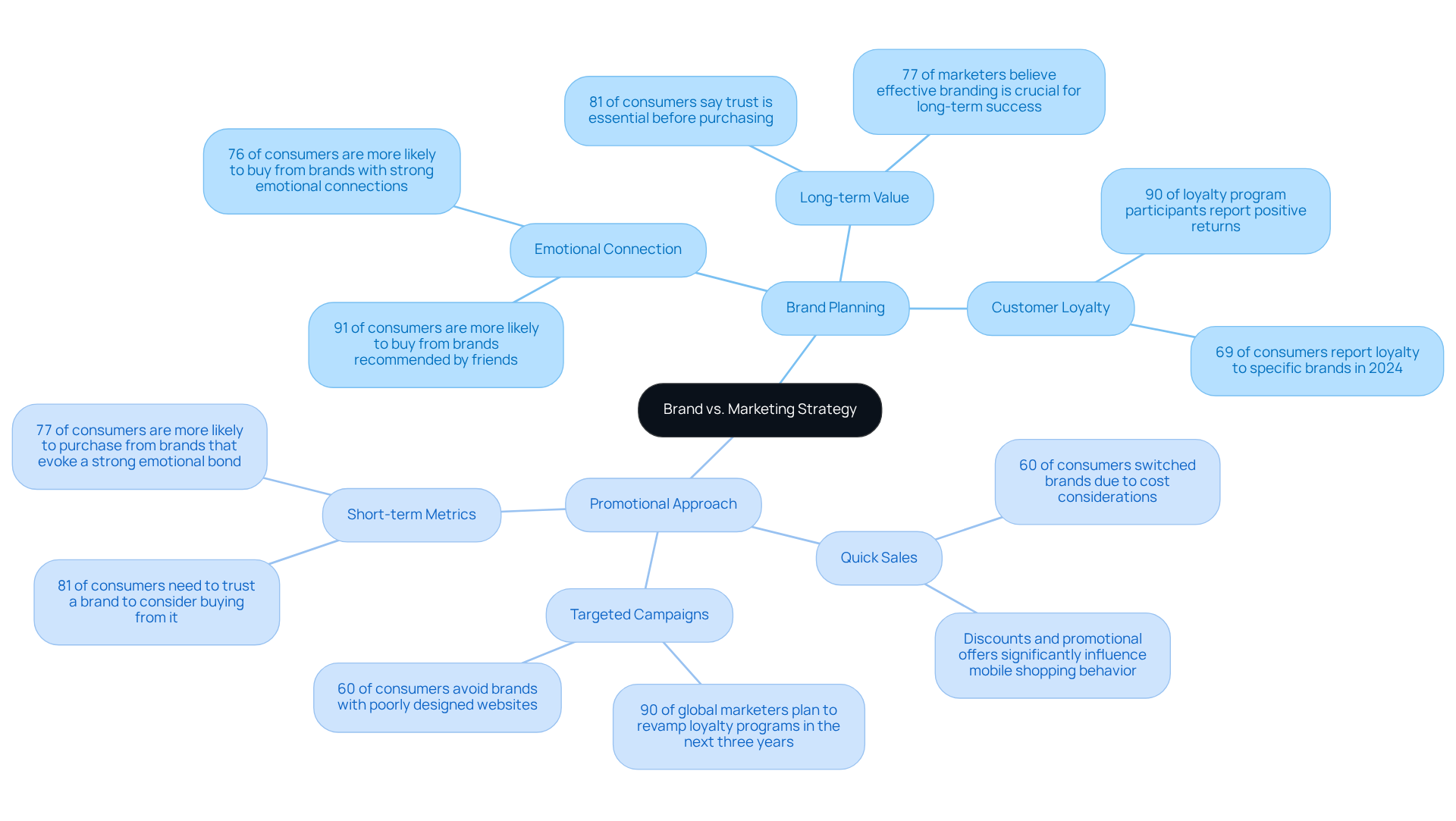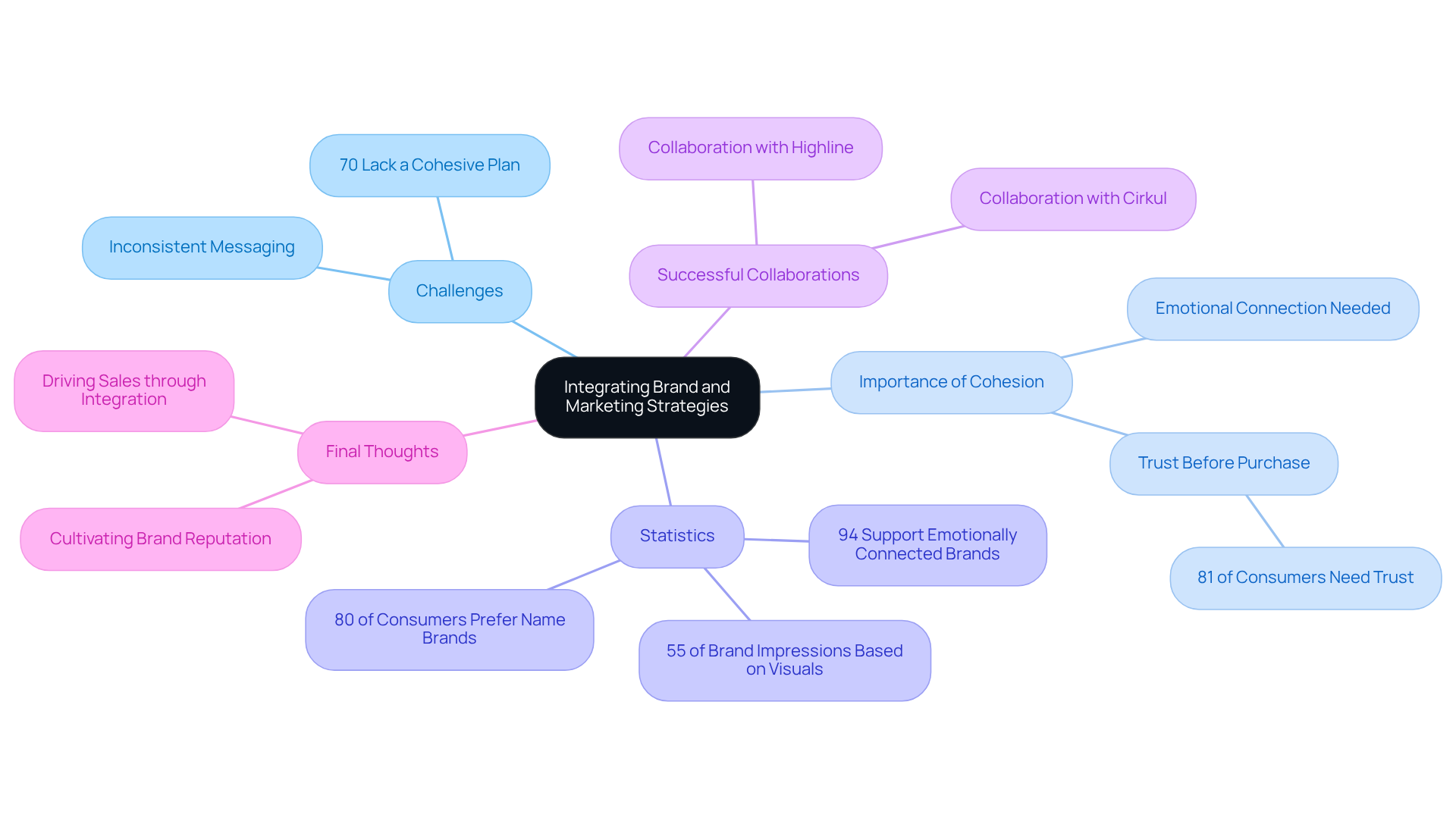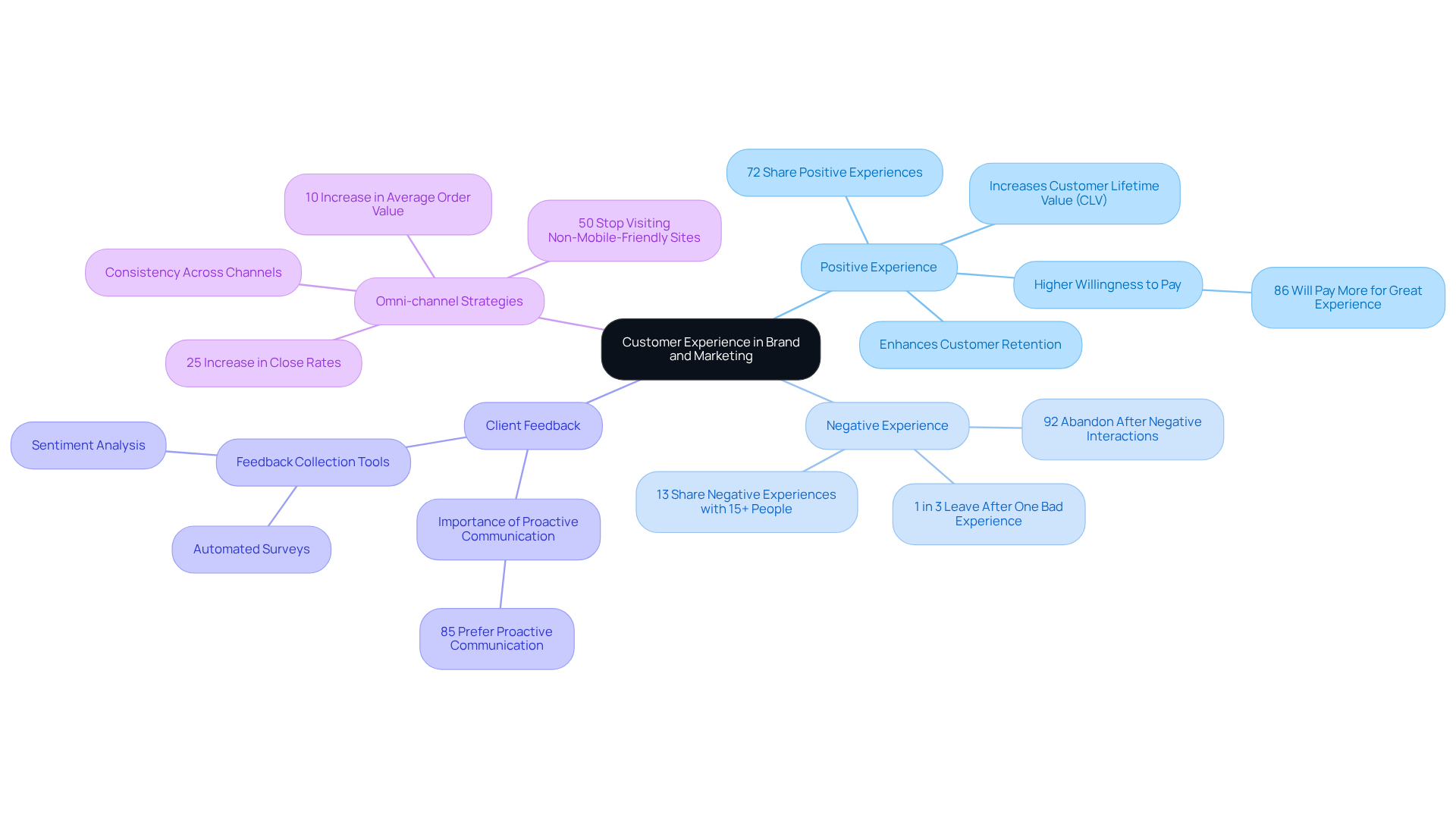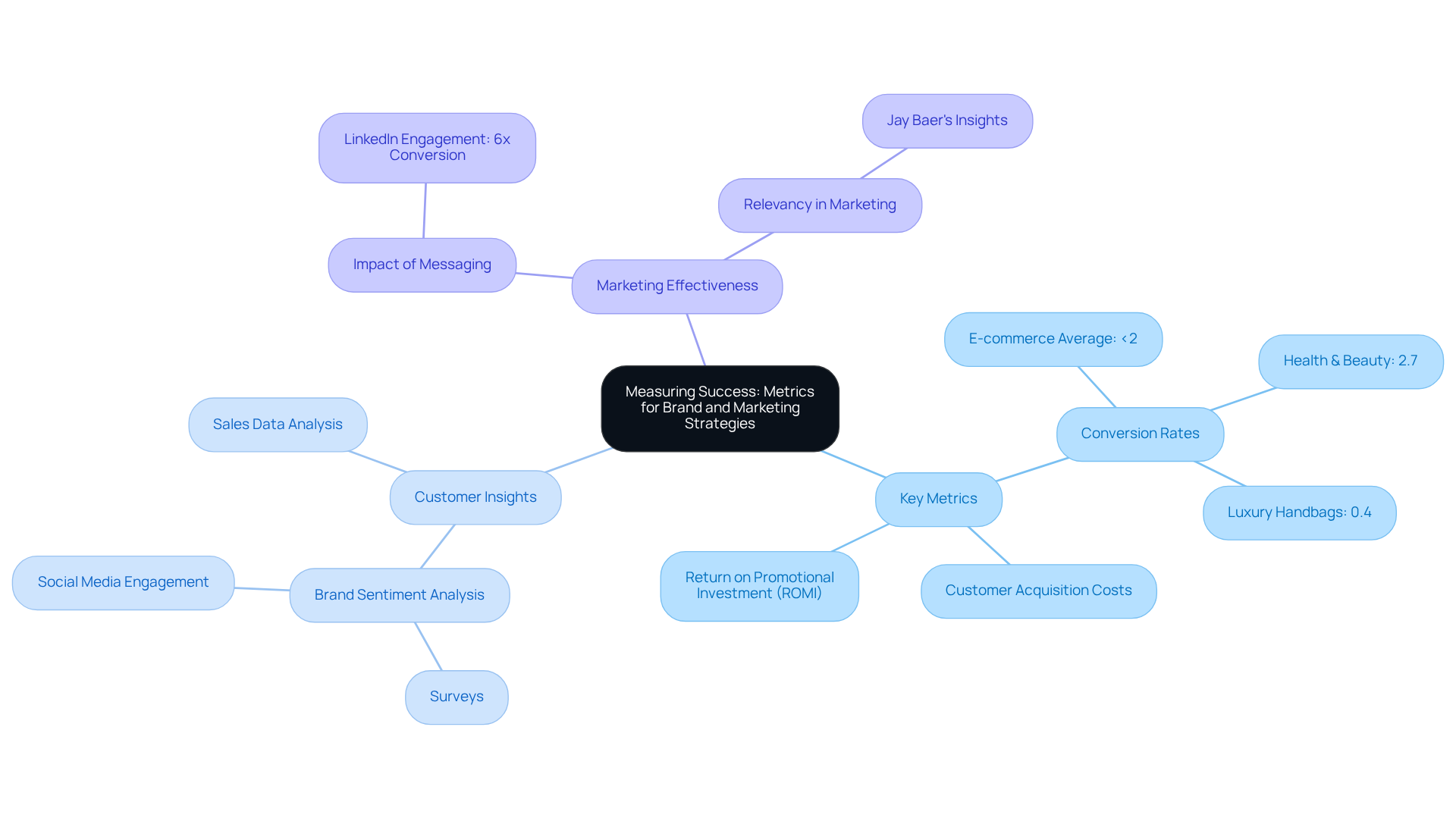Overview
In today's competitive landscape, many tech startup founders face the challenge of distinguishing their brand in a crowded market. This fragmented approach can lead to confusion and a lack of emotional connection with customers. The implications of this are significant, as without a cohesive brand identity, fostering customer loyalty becomes increasingly difficult.
Research shows that emotional connections and consistent branding are not just beneficial; they are essential for influencing consumer purchasing decisions and enhancing overall marketing effectiveness. By nurturing a strong brand identity, you can create a lasting impact that resonates with your audience.
At RNO1, we understand the importance of this journey. We are here to support you in crafting a brand strategy that not only drives growth but also builds meaningful relationships with your customers. Together, we can transform your vision into a compelling narrative that engages and inspires.
Introduction
In a marketplace overflowing with choices, many businesses find themselves grappling with the crucial distinction between brand strategy and marketing strategy. This challenge can feel overwhelming, especially for those aiming to thrive amidst fierce competition. While both strategies are essential for growth, they serve different purposes:
- Brand strategy is about crafting a compelling identity that fosters loyalty.
- Marketing strategy focuses on driving immediate sales through targeted campaigns.
This raises an important question: how can companies effectively align these two strategies? Misalignment can lead to missed opportunities, leaving businesses struggling to capture attention and build lasting connections with their audience. However, by exploring this dynamic interplay, we can uncover valuable insights that transform promotional efforts into powerful tools for sustained success. Together, let’s navigate this journey and find ways to harmonize your brand and marketing strategies for a brighter future.
Defining Brand Strategy and Marketing Strategy
In the world of brand strategy and marketing, many founders grapple with a common challenge: the struggle to define a cohesive identity that resonates with their audience. This issue can lead to a disconnect, where the emotional connection that is so vital to consumer loyalty is overlooked. It’s concerning to realize that without a clear identity, promotional efforts may fall flat, missing opportunities for meaningful engagement and lasting loyalty. Research indicates that 68% of consumers feel that a company's narrative influences their purchasing decisions. This statistic highlights just how critical it is to foster that emotional bond.
Moreover, the promotional approach often becomes a tactical exercise focused solely on achieving sales goals. It involves pinpointing target markets, determining pricing strategies, and selecting communication channels. Yet, without a underpinning these tactics, the efforts can lack coherence. This misalignment can lead to missed opportunities for connection, as the messaging fails to resonate with potential customers. In fact, 77% of promotional leaders emphasize that a robust identity is essential for their growth strategies, underscoring the need for a clearly articulated identity to guide all promotional activities.
By aligning their brand strategy and marketing efforts with a well-defined identity, brands not only reflect their core values but also engage their audience on a deeper level. This alignment nurtures loyalty and enhances overall marketing effectiveness. Successful branding can lead to numerous advantages, such as increased loyalty, a positive image, and a relatable identity. Conversely, inconsistent branding can negatively impact perception and even employee morale. As you navigate these challenges, remember that fostering a strong identity is not just a marketing strategy; it’s a pathway to building lasting relationships with your audience.

Comparing Goals and Focus: Brand vs. Marketing Strategy
Brand planning aims to cultivate a strong and recognizable identity that nurtures customer loyalty and trust over time. This approach highlights long-term value and the emotional connections consumers form with a brand. However, the promotional approach is designed to generate quick sales and revenue through targeted campaigns, often focusing on short-term metrics like conversion rates and return on investment (ROI). For example, while a product approach might leverage storytelling and core values to resonate with consumers, a promotional strategy would prioritize tactics like discounts or advertising campaigns.
The significance of customer loyalty in marketing strategy is profound; 81% of consumers express that trust is vital before making a purchase. This underscores the necessity for companies to build . Furthermore, brands that foster strong emotional connections see a 76% increase in purchase likelihood, illustrating how loyalty drives commercial success. This relationship between customer loyalty and promotional effectiveness is crucial, as 90% of loyalty program participants report positive returns, averaging 4.8 times their investment.
Marketing experts emphasize the importance of balancing brand identity with brand strategy and marketing tactics. One expert remarked that effective branding, which is a crucial part of brand strategy and marketing, is essential for long-term success, with 77% of marketers agreeing that consistent branding efforts yield better outcomes than short-term sales spikes. Additionally, 73% of Millennials express loyalty to their favorite brands, highlighting generational differences in brand attachment. This comparison illustrates the necessity for companies to blend both approaches, fostering lasting connections with consumers while also achieving short-term sales objectives. Moreover, with 90% of global marketers planning to revamp loyalty initiatives in the next three years, it’s evident that adapting loyalty strategies is vital for maintaining customer engagement.

Integrating Brand and Marketing Strategies for Effective Growth
In today's competitive landscape, many tech startup founders face the challenge of effectively combining brand strategy and marketing. This struggle can lead to inconsistent messaging, leaving potential customers confused and disconnected. Imagine a technology startup that has a compelling story but fails to convey it through its promotional campaigns. This disconnect not only dilutes the company’s identity but also hinders its ability to resonate with the intended audience.
It’s essential to recognize that a unified brand strategy and marketing does more than just align promotional activities with the company’s identity; it fosters a deeper connection with customers. For example, utilizing a startup's narrative in promotional efforts can create a cohesive message that reflects its values and mission. By implementing style guidelines for promotional materials, organizations can ensure that all communications resonate with their unique voice and personality.
However, studies reveal that 70% of promotional teams lack a cohesive content plan, underscoring the urgency of this integration. Without a clear strategy, the that consumers seek may be lost. In fact, 81% of consumers need to trust a brand before making a purchase, highlighting the critical nature of having a unified identity and promotional approach.
RNO1 has witnessed firsthand how successful collaborations, like those with Highline and Cirkul, can transform customer engagement. These partnerships have shown that customized digital experiences not only enhance engagement but also significantly boost sales. It’s heartening to note that 94% of consumers support companies they feel emotionally connected to, reinforcing the importance of emotional involvement in promotional strategies.
Ultimately, by adopting a well-integrated approach to brand strategy and marketing, tech startups can cultivate their brand reputation while driving sales, creating a virtuous cycle of growth. At RNO1, we are here to support you on this journey, helping you build a strong, relatable brand that resonates with your audience and fosters lasting connections.

The Role of Customer Experience in Brand and Marketing Strategies
Customer experience is a crucial element that significantly shapes both identity and promotional strategies. A positive client experience not only fosters loyalty to the company but also encourages repeat business. Conversely, a negative experience can severely damage a company's reputation and undermine promotional efforts. For instance, tech startups that prioritize user-friendly design and attentive client service are more likely to cultivate a strong brand image and benefit from positive word-of-mouth promotion. It's disheartening to know that 92% of clients would abandon a company after just two or three negative interactions, underscoring the importance of maintaining high service standards.
Moreover, incorporating client feedback into brand strategy and marketing enables companies to pinpoint areas for improvement and innovation. By placing a strong emphasis on exceptional client experiences, businesses can effectively set themselves apart in a competitive market through their brand strategy and marketing, building lasting connections with their audience. This approach not only but also drives growth. Organizations that adopt robust omni-channel strategies witness a 10% increase in average order value, while 50% of clients will stop visiting a website that isn’t mobile-friendly. Alarmingly, 1 in 3 clients will abandon a cherished company after just one negative encounter, and 9 out of 10 enterprises compete primarily on client experience. Furthermore, over 85% of clients prefer proactive communication from companies, highlighting the need for businesses to anticipate client needs. Case studies reveal that companies focused on client experience can significantly enhance their market position. Let's work together to prioritize these experiences and create a nurturing environment for our clients.

Measuring Success: Metrics for Brand and Marketing Strategies
Assessing achievement in promotional efforts can feel daunting for many tech startup founders, especially when it comes to identifying the right metrics that align with their individual goals. The challenge often lies in evaluating the effectiveness of branding approaches. Metrics like awareness, loyalty, and equity serve as indicators of how the brand is perceived in the marketplace. However, the success of promotional strategies is typically gauged through:
- Conversion rates
- Customer acquisition costs
- Return on promotional investment (ROMI)
For instance, a technology startup may find it beneficial to evaluate brand sentiment through surveys and social media engagement, gaining valuable insights into their brand health. Simultaneously, they can analyze sales data to measure the success of specific promotional campaigns.
It's important to note that conversion rates for e-commerce sites average under 2%, with health and beauty online shopping achieving the highest rates at 2.7%, while luxury handbags see the lowest at just 0.4%. This stark reality emphasizes the need for to enhance promotional efforts. Furthermore, when individuals encounter promotional messages on LinkedIn, they are six times more likely to convert, underscoring the importance of crafting effective messaging.
By employing a combination of these metrics, companies can gain a well-rounded perspective of their performance, enabling them to make informed decisions that enhance their brand strategy and marketing. As Jay Baer insightfully points out, a lack of relevance is a significant contributor to promotional failures, highlighting the necessity for advertisers to ensure their strategies resonate with their audience. Additionally, it's noteworthy that 85% of marketers with a service level agreement (SLA) believe their marketing strategy is effective, showcasing the perceived value of structured approaches in achieving marketing success.
Remember, you are not alone in this journey; by embracing these insights and metrics, you can navigate the complexities of promotional efforts with confidence and clarity.

Conclusion
Understanding the distinctions between brand strategy and marketing strategy is essential for fostering growth in any business. Many companies struggle with creating a coherent identity that resonates with consumers and cultivates the emotional connections necessary for loyalty and long-term success. This disconnection can lead to missed opportunities and frustration. By recognizing that brand strategy lays the foundation for marketing efforts, businesses can avoid the pitfalls of disjointed messaging and instead create a unified approach that enhances both brand reputation and sales performance.
Key insights illustrate the importance of aligning brand identity with marketing tactics. The significant role of customer loyalty, the necessity for cohesive messaging, and the impact of customer experience all converge to highlight how a well-integrated strategy can drive growth. Statistics show that 68% of consumers are influenced by a company's narrative, while 81% need to trust a brand before making a purchase. These figures emphasize the critical nature of a strong brand foundation, which can be a source of reassurance for businesses aiming to connect more deeply with their audience.
Ultimately, the integration of brand and marketing strategies is not just a theoretical exercise; it is a practical necessity for businesses aiming to thrive in a competitive landscape. As companies adapt their strategies to foster emotional connections with consumers and prioritize exceptional customer experiences, they position themselves for sustainable growth. Embracing these insights and actively working towards a cohesive strategy will not only enhance brand loyalty but also ensure that promotional efforts yield meaningful results. Together, we can navigate this journey, fostering connections that truly matter.
Frequently Asked Questions
What is the main challenge faced by founders in defining brand and marketing strategies?
Founders often struggle to define a cohesive identity that resonates with their audience, which can lead to a disconnect and overlook the emotional connection vital for consumer loyalty.
How does a company's narrative influence consumer purchasing decisions?
Research indicates that 68% of consumers feel that a company's narrative influences their purchasing decisions, highlighting the importance of fostering an emotional bond with customers.
What is the difference between brand strategy and marketing strategy?
Brand strategy focuses on cultivating a strong and recognizable identity that nurtures customer loyalty and trust over time, while marketing strategy aims to generate quick sales and revenue through targeted campaigns and short-term metrics.
What percentage of consumers believe trust is vital before making a purchase?
81% of consumers express that trust is vital before making a purchase, emphasizing the need for brands to build credibility and authenticity.
How does customer loyalty impact purchase likelihood?
Brands that foster strong emotional connections see a 76% increase in purchase likelihood, illustrating the significant relationship between loyalty and commercial success.
What do marketing experts say about balancing brand identity with marketing tactics?
Marketing experts emphasize the importance of balancing brand identity with brand strategy and marketing tactics, noting that consistent branding efforts yield better outcomes than focusing solely on short-term sales.
What is the significance of loyalty programs according to the article?
90% of loyalty program participants report positive returns, averaging 4.8 times their investment, indicating the effectiveness of loyalty initiatives in enhancing customer engagement.
How do generational differences affect brand loyalty?
73% of Millennials express loyalty to their favorite brands, highlighting the need for companies to understand and adapt to generational differences in brand attachment.
What is the future outlook for loyalty initiatives according to global marketers?
90% of global marketers plan to revamp loyalty initiatives in the next three years, indicating the necessity of adapting loyalty strategies to maintain customer engagement.




